CHINESE ART
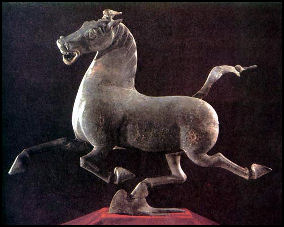
Han-era bronze horse Chinese art and Asian art in general can not be approached in the same way that Western art is. Asian artists in many cases are motivated by different forces and create art in accordance with different principals than Western artists.
One of the first things that stands out about Chinese art is that there is so much more to it than painting and sculpture. Crafts and calligraphy occupy a place that is of equal if not greater importance than painting and sculpture.
Unlike artists in the West who were either skilled craftsmen paid by the hour or professional artists who were commissioned to produce unique works of art, many Chinese artists were amateur scholar gentlemen "following revered ancients in harmony with forces of nature." Calligraphy and painting were seen as scholarly pursuits of the educated classes, and in most cases the great masters of Chinese art distinguished themselves first as government officials, scholars and poets and were usually skilled calligraphers. Sculpture, which involved physical labor and was not a task performed by gentlemen, never was considered a fine art in China.
Most Chinese are as ignorant of Western art as Westerners are of Eastern art. Many Chinese are familiar with Michelangelo, Picasso and van Gogh but don't have a clue who Vermeer, Marcel Duchamp or Andy Warhol are. Writing about Chinese art coherently is difficult because there are so many different art forms, so many different historical periods, so many different themes and so many different ethnic groups, influences and regional art forms. Moreover, so much Chinese art has been lost or destroyed, creating big gaps in the historical records. Even experts of Chinese art are learning new stuff all the time.
Links in this Website: EARLY CHINESE ART Factsanddetails.com/China ; CHINESE ART FROM THE GREAT DYNASTIES Factsanddetails.com/China ; SHANG DYNASTY (2200-1700 B.C.) AND XIA DYNASTY Factsanddetails.com/China ; ZHOU (CHOU) DYNASTY (1100-221 B.C.) Factsanddetails.com/China ; HAN DYNASTY (206 B.C.-A.D. 220) Factsanddetails.com/China ; TANG DYNASTY (A.D. 690-907) Factsanddetails.com/China ; SONG DYNASTY (960-1279) Factsanddetails.com/China ;YUAN (MONGOL) DYNASTY (1215-1368) MING DYNASTY (1368-1644) Factsanddetails.com/China ; QING (MANCHU) DYNASTY (1644-1911) Factsanddetails.com/China ; CHINESE JADE Factsanddetails.com/China ; CHINESE CERAMICS AND PORCELAIN Factsanddetails.com/China ; CHINESE PAINTING Factsanddetails.com/China ;CHINESE CALLIGRAPHY Factsanddetails.com/China ; CHINESE CRAFTS Factsanddetails.com/China ; COLLECTING, LOOTING AND COPYING ART IN CHINA Factsanddetails.com/China
RECOMMENDED BOOKS: “The Arts of China” by Michael Sullivan and Shelagh Vainker Amazon.com; “Chinese Art: A Guide to Motifs and Visual Imagery” by Patricia Bjaaland Welch Amazon.com; “Chinese Art: (World of Art) by Mary Tregear Amazon.com; “Art in China (Oxford History of Art) by Craig Clunas Amazon.com; “Possessing the Past: Treasures from the National Palace Museum, Taipei” by Wen C. Fong, and James C. Y. Watt Amazon.com ; “The British Museum Book of Chinese Art” by Jessica Rawson, et al Amazon.com
Chinese Approaches to Works of Art
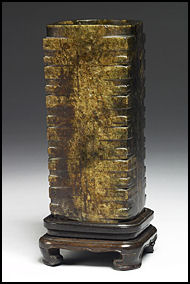
4,500 year old piece
in the Palace Museum According to Columbia University’s Asia for Educators: “Personal Expression Valued Over "Realism": Although "realistic" painting in the European style was very much in vogue at the Qing court, where it was appreciated for its documentary value in commemorating the Qianlong Emperor's exploits, it was not regarded as "high art." The Chinese and their Manchu rulers held to the belief that the highest form of pictorial expression was traditional Chinese painting, which privileged the personal expression of the individual artist over the representation of external appearances. Since the 14th century what mattered most in Chinese painting was the artist's ability to express his personal feelings — to create an image of his interior world — rather than to describe the external appearances of things. As a result, most Chinese painting connoisseurs regarded the European style as little more than a gimmick. [Source: Asia for Educators, Columbia University, Maxwell K. Hearn, Consultant, learn.columbia.edu/nanxuntu]
“The Importance of Poetry for Artists and Connoisseurs: Chinese literati artists often wrote poems directly on their paintings. This practice emphasized the importance of both poetry and calligraphy to the art of painting and also highlighted the notion that a painting should not try to represent or imitate the external world, but rather to express or reflect the inner state of the artist. The artist's practice of writing poetry directly on the painting also led to the custom of later appreciators of the work — perhaps the initial recipient of the painting or a later owner — adding their own reactions to the work, often also in the form of poetry. These inscriptions could be added either directly on the surface of the painting, or sometimes on a sheet of paper mounted adjacent to the painting. In this way some handscrolls accommodated numerous colophons by later owners and admirers. Thus in Chinese art the act of ownership entailed the responsibility of not only caring for the work properly, but to a certain extent also recording one's response to it.
“The Qianlong Emperor (ruled 1735-1796.) was an avid collector and connoisseur of Chinese art, and the number of paintings and artifacts collected during his reign was unprecedented. Many palace halls were used specifically for the Emperor to admire and study works of art. The Qianlong Emperor had a tendency to admire the works he collected and commissioned by adding a great number of seals and inscriptions — usually in the form of poems — to the works. In so doing, the emperor not only endowed these works of art with the imperial imprimatur but also, by leaving his mark on some of the most important works of Chinese art, asserted his control over Chinese culture and his legitimacy as the ultimate connoisseur of Chinese art. Often he must have had ghost writers helping him inscribe these poems, but he did write many of them himself. In fact, the Qianlong Emperor is said to have composed some 40,000 poems, and many of them are inscribed on the enormous collection of paintings amassed during his reign. As a result, the Qianlong Emperor's inscriptions and seals appear on hundreds of the most important Chinese paintings that exist today.
“The Work of Art as a Dialogue with the Past: The Role of Owners and Connoisseurs, One of the most extraordinary characteristics of Chinese painting is that, in a way, a painting is never quite finished. What does this mean? Just as the artists themselves used poetry as a medium of expression in painting, later appreciators of a painting felt free to add to it by writing a poem in response to the work, or sometimes just adding a personal seal, directly on the surface of the painting or to the silk mounting bordering the painting. In this way a painting remains "open-ended," and viewing a painting is like engaging in an ongoing conversation, not only with the artist, but with all the people who have in the past owned the work and have recorded their response to it. And through this visual record, a painting's provenance can be traced, so that literally written on the surface of the painting is the very history of who owned it, how people over time have appreciated it, and how different eras saw its merits in a different light. When a connoisseur looks at a painting today, he or she not only examines the work, but takes great delight in seeing which other collectors owned it, and what some of these owners and other commentators have had to say about it.”
Literati and Academic Traditions in Chinese Art
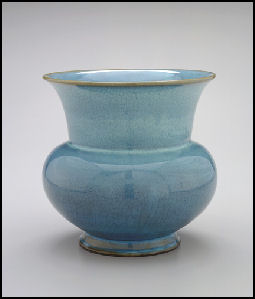
Asian artists have traditionally learned their crafts from senior family members or masters, whose wisdom is regarded as beyond reproach and whose authority is not questioned. Experimentation, improvisation and innovation are taken as an insult to the master and are not to be undertaken only if the student becomes a master himself. The Socratic approach of learning through questioning is not encouraged. There is a risk of humiliating the master if he doesn't known the answer, plus asking a lot of questions is considered rude.Students are often like apprentices. During the early stages of their the learning process, they are often treating like servants. They spend their time cleaning and serving, doing tasks that have nothing to do with the craft, and are supposed to take every opportunity they can to observe their master at work.
According to the literati ideal in imperial and traditional China an educated gentlemen aspiring to government service should also be an accomplished poet and painter. Dr. Robert Eno of Indiana University wrote: “ By looking at the way that the members of the governing elite approached the art of painting, we can gain some further insight into the way in which they conceived and tried to live up to the literati ideal. The key division that we will emphasize here is one between men who were called "academic" painters, and those who were seen as painters in the literati tradition. What's the difference? [Source: Robert Eno, Indiana University]
Academic painters were highly skilled craftsmen, who aimed to achieved marvelous effects through their use of colors, realistic or highly conventional representations of people or things, spectacular detail, applications of shiny gold leaf, and so forth. The Imperial court employed many such men, and others made their way in the world by selling their paintings to wealthy patrons and customers.
"Academic painters" were professionals, both in their virtuoso skills, and in the fact that they depended on permanent employment as painters, or on selling their paintings to live. While many of these men were educated to some degree, few possessed the literary background of a literatus, and none made their way in life fulfilling the Confucian ideal of governmental service. "Literati painters," on the other hand, were amateurs — they painted as a means of self-expression, much the same way they wrote poetry; both forms were inheritances from the Neo-Daoist era of the Six Dynasties. While many fewer literati were accomplished painters than were poets (and painting was never an aspect of the exams), in every major place in China there were always many literati who either painted on the side, while playing the role of scholar-officials, or who, through wealth, could afford to devote themselves fully to the art of painting.
“Literati painting was conceived as mode through which the Confucian junzi (noble person) expressed his ethical personality. It was much less concerned with technical showiness. Literati painters specialized in plain ink paintings, sometimes with minimal color. They lay great emphasis on the idea that the style with which a painter controlled his brush conveyed the inner style of his character — brushstrokes were seen as expressions of the spirit more than were matters of composition or skill in realistic depiction. /+/
“While literati poetry developed fully during the Tang Dynasty on the basis of long Six Dynasties preparation, painting did not become central to literati until later. Although we hear of famous poet-painters of the Tang, because their works have not survived it is difficult to know to what degree their art differed from academic painting. During the late Song, however — that is, after about 1200 — literati and academic painting become two distinct streams. Interestingly, although academic paintings were often far more skilled in technique, many felt — and still feel — that the "amateur" ink paintings of the literati are the highest form of art in China. The most important of the painters we will look at is a man named Shen Zhou (1427-1509), who lived during the Ming Dynasty (1368-1644).” His approach to his art illustrates many key facets of the Confucian-Daoist literati ideal, translated into an approach to painting.
Nature in Chinese Art
Serenity and tranquil beauty have traditionally been valued in Chinese culture and aesthetics. Fei Bo, a Chinese choreographer, told The Times: “Our culture is more about spiritual things, and nature is much more important to us. In our traditional painting the strokes are very simple but they leave a big space for your imagination.”

Jade suit of Liu Sheng, 113 B.C.
According to the Metropolitan Museum of Art: “In no other cultural tradition has nature played a more important role in the arts than in that of China. Since China's earliest dynastic period, real and imagined creatures of the earth—serpents, bovines, cicadas, and dragons—were endowed with special attributes, as revealed by their depiction on ritual bronze vessels. In the Chinese imagination, mountains were also imbued since ancient times with sacred power as manifestations of nature's vital energy (qi). They not only attracted the rain clouds that watered the farmer's crops, they also concealed medicinal herbs, magical fruits, and alchemical minerals that held the promise of longevity. Mountains pierced by caves and grottoes were viewed as gateways to other realms—"cave heavens" (dongtian) leading to Daoist paradises where aging is arrested and inhabitants live in harmony. [Source: Metropolitan Museum of Art metmuseum.org \^/]
“From the early centuries of the Common Era, men wandered in the mountains not only in quest of immortality but to purify the spirit and find renewal. Daoist and Buddhist holy men gravitated to sacred mountains to build meditation huts and establish temples. They were followed by pilgrims, travelers, and sightseers: poets who celebrated nature's beauty, city dwellers who built country estates to escape the dust and pestilence of crowded urban centers, and, during periods of political turmoil, officials and courtiers who retreated to the mountains as places of refuge.\^/
“Early Chinese philosophical and historical texts contain sophisticated conceptions of the nature of the cosmos. These ideas predate the formal development of the native belief systems of Daoism and Confucianism, and, as part of the foundation of Chinese culture, they were incorporated into the fundamental tenets of these two philosophies. Similarly, these ideas strongly influenced Buddhism when it arrived in China around the first century A.D. Therefore, the ideas about nature described below, as well as their manifestation in Chinese gardens, are consistent with all three belief systems.\^/
“The natural world has long been conceived in Chinese thought as a self-generating, complex arrangement of elements that are continuously changing and interacting. Uniting these disparate elements is the Dao, or the Way. Dao is the dominant principle by which all things exist, but it is not understood as a causal or governing force. Chinese philosophy tends to focus on the relationships between the various elements in nature rather than on what makes or controls them. According to Daoist beliefs, man is a crucial component of the natural world and is advised to follow the flow of nature's rhythms. Daoism also teaches that people should maintain a close relationship with nature for optimal moral and physical health.\^/
“Within this structure, each part of the universe is made up of complementary aspects known as yin and yang. Yin, which can be described as passive, dark, secretive, negative, weak, feminine, and cool, and yang, which is active, bright, revealed, positive, masculine, and hot, constantly interact and shift from one extreme to the other, giving rise to the rhythm of nature and unending change.\^/
“As early as the Han dynasty, mountains figured prominently in the arts. Han incense burners typically resemble mountain peaks, with perforations concealed amid the clefts to emit incense, like grottoes disgorging magical vapors. Han mirrors are often decorated with either a diagram of the cosmos featuring a large central boss that recalls Mount Kunlun, the mythical abode of the Queen Mother of the West and the axis of the cosmos, or an image of the Queen Mother of the West enthroned on a mountain. While they never lost their cosmic symbolism or association with paradises inhabited by numinous beings, mountains gradually became a more familiar part of the scenery in depictions of hunting parks, ritual processions, temples, palaces, and gardens. By the late Tang dynasty, landscape painting had evolved into an independent genre that embodied the universal longing of cultivated men to escape their quotidian world to commune with nature. The prominence of landscape imagery in Chinese art has continued for more than a millennium and still inspires contemporary artists.” \^/
Later when the learning process begins, the student is expected observe and copy his master. Students are supposed to hang on every word the master says and are supposed to do things exactly as the master does.
Chinese Symbols
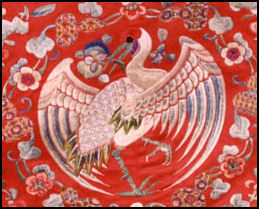
Crane, symbol of joy
The most prominent Chinese animal symbols are: 1) cranes (peace, hope, healing, longevity and good luck); 2) turtles (long life, but a tortoise refers to a cuckolded husband and a turtle egg is the Chinese equivalent of a bastard); 3) carps (good luck, they are admired for their strength and determination to swim upstream, traits that parents want their children to have): 4) lions (good fortune and prosperity, stone lion gates guard temples and even shopping malls); 5) deer (wealth and long life); 6) horse (success); 7) sheep (auspicious beginning of a brand-new year); 8) monkey (success);
Fruit symbols: 1) orange (happiness); 2) many-seeded pomegranate (fertility); 3) apple (peace); 4) pear (prosperity); 5) peaches (long life, good health and sex, both Chinese and Arabs regard the fury cleft on one side of the peach as symbol of the female genitalia). Peach trees mean dreams can come true. Beginning in the 2nd century B.C., Taoist kept peach-wood charms to ward off evil. Sometimes handmade noodles are served on birthdays for long life.
Well-known symbols of prosperity and good luck are: 1) jade (protection, health and strength, See Art); 2) eggs (tranquility, fertility and good luck in Hong Kong); 3) a bearded sage (longevity or success on exams); 4) a lady bearing fruit (prosperity); 5) a gourd with spreading tendrils (fertility); 6) plump, lively boys (happiness and many sons); 7) bamboo, plums and pine trees ("three friends of winter").
Imperial symbols included the colors yellow and purple. The Emperor wore yellow robes and lived under roofs made with yellow tiles. Only the Emperor was allowed to wear yellow. No buildings outside those in the Forbidden City were allowed to have yellow-tiled roofs. Purple represented the North Star, the center of the universe according to Chinese cosmology.
The dragon symbolized the Emperor while the phoenix symbolized the Empress. The cranes and turtles associated with the Imperial court represented the desire for a long reign. The numbers nine, associated with male energy, and five, representing harmony were also linked with the Emperor.
See Separate Article DRAGONS AND AUSPICIOUS AND ARTISTIC SYMBOLS IN CHINA factsanddetails.com
Longevity Symbols in Chinese Art
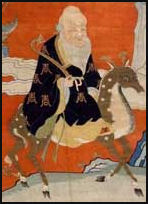
Longevity sage
Joyce Denney of the Metropolitan Museum of Art wrote: “ The pursuit of longevity has played an unusually notable role in China. Societal respect for the elderly (a generally Confucian value) and the individual's search for longevity or immortality (a loosely Daoist concern) resulted in a preoccupation with long life that was reflected in the visual arts. By the time of the Ming (1368–1644) and Qing (1644–1911) dynasties, certain motifs and stories associated with long life had become fundamental themes in paintings, on garments, and in the decorative arts that were appropriate as gifts, dress, and furnishings for occasions such as birthday and retirement celebrations. Among the themes are the character for longevity itself, immortals and certain legendary figures, motifs such as peaches associated with immortals, and, finally, other motifs connected to long life through physical attributes or word play. [Source: Joyce Denney, Department of Asian Art, Metropolitan Museum of Art metmuseum.org \^/]
“A decorative motif in itself, the character for longevity (shou) can appear in at least 100 variant forms and frequently occurs on hangings, garments, and decorative arts that were appropriate for auspicious occasions such as birthday celebrations. The swastika often appears with the shou character and reinforces its auspicious meaning. An ancient symbol originating in India, the swastika is called wan in Chinese and denotes 10,000 years; the pairing of wan and shou also occurred in the name given to the celebration of the emperor's birthday in the Qing dynasty: wanshoujie, literally, "festival of 10,000-year longevity." \^/
“Considered part of the pantheons of Daoism and Chinese popular religion, immortals were readily adopted as subjects in secular arts. The god of longevity, Shoulao, easily recognized by his prominent cranium, is sometimes accompanied by a deer or rides on the back of a crane. Among his companions are the eight Daoist immortals, legendary figures sometimes represented in the visual arts only by their attributes, such as the crutch and gourd of Li Tieguai. The queen mother of the west (Xiwangmu) figured in stories about the peaches of immortality that grew in her celestial peach orchard. The peaches conferred immortality on anyone who ate them. Xiwangmu freely offered the peaches to gods and to certain deserving mortals, and they were served at banquets she hosted. Sometimes, however, peaches were taken without her permission. For example, the legendary Han-dynasty official Dongfang Suo stole peaches from the orchard and thus illegitimately achieved immortality.\^/
“Other legendary figures were associated with longevity. One scene frequently represented in large-scale works was the eightieth birthday reception for General Guo Ziyi, a heroic figure of the Tang dynasty who was transformed into a popular god of wealth, honor, and happiness. The birthday reception, a celebration of his long and fruitful life, often appeared on works commissioned for birthdays, retirements, or promotions of distinguished individuals.\^/
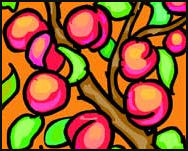
Peaches
“The peach, even without the physical presence of Xiwangmu, had a strong link to longevity. The peach is seen in drinking cups, decorative vases, and even scholars' objects such as ink tablets. Works with patterns of blossoming peach branches and trees evoke not only the peach orchard of Xiwangmu but also the story of the peach blossom spring, from a poem by Tao Yuanming (365–427) in which the ordinary but immortal populace of an ethereal village located in a grove of blossoming peach trees lives without being aware of the passage of time or the pressures of the world.\^/
“Motifs were sometimes connected to long life through physical attributes. Long-lived and evergreen, pines were associated with longevity. Cranes were already linked to long life through their role as conveyences of the immortals; in addition, their white feathers could also bring to mind the white hair of the elderly and, when seen in pairs, could obliquely refer to an elderly couple. This association also held true for small birds with white-feathered heads, common in paintings given as birthday gifts to elderly couples. The physical property of length was also associated with long life. The peanut plant was linked to longevity not only because of the perceived healthfulness of the peanut as food but also because of the plant's long root system. Long-tailed birds and long ribbons were also connected with long life.\^/
“Sometimes word play allowed a pattern usually associated with one auspicious wish to express another instead. For example, the butterfly was primarily associated with joy and weddings, but because its name (hudie) is a pun for "age seventy to eighty," it also symbolized longevity. Motifs symbolic of longevity were often combined with patterns associated with other desirable conditions, such as happiness, wealth, and attaining high rank. For example, bats, symbolic of blessings, often occur among longevity motifs (65.210.2). Decorative arts, paintings, and garments with longevity themes provided a generalized sense of auspiciousness, and the motifs were sometimes mixed with other patterns to form pleasing works appropriate for many occasions. \^/
Mongol Symbols in Chinese Art
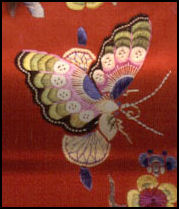
Butterfly, symbol of joy
Stefano Carboni and Qamar Adamjee of the Metropolitan Museum of Art wrote: “ In the creation of luxury textiles and objects for the Mongol elite, Chinese artists developed a visual language that was an effective means of establishing their rule and consolidating their presence throughout the vast empire. A number of motifs that were part of the existing artistic repertoire were adopted as imperial symbols of power and dominance—the dragon and the phoenix, for example, two mythical beasts that integrated the ideas of cosmic force, earthly strength, superior wisdom, and eternal life. The Mongol versions of the creatures are the highly decorative sinuous dragon with legs, horns, and beard and the large bird with a spectacular feathered tail floating in the air (12.49.4). In Iran, these motifs were often paired and became so popular with the Ilkhanids that they eventually lost their original meaning, becoming part of the common artistic repertoire in the first half of the fourteenth century. [Source:Stefano Carboni and Qamar Adamjee, Department of Islamic Art, Metropolitan Museum of Art metmuseum.org \^/]
“Other motifs of this period that were familiar throughout the Asian continent are the peony, the lotus flower (91.1.559), and the lyrical image of the recumbent deer, or djeiran, gazing at the moon. The flowers, often seen in combination and viewed from both the side and top, provided ideal patterns for textiles and for filling dense backgrounds on all kinds of portable objects. The djeiran became widespread in the decorative arts because of the well-established association of similar quadrupeds with hunting scenes.\^/
“For the semi-nomadic Mongols, portable textiles and clothing were the best means of demonstrating their acquired wealth and power, so it is reasonable to assume that the main mode of transmission of motifs such as the dragon and peony was through luxury textiles. The most prominent clothing accessories were belts of precious metal (gold belt plaques, The Nasser D. Khalili Collection of Islamic Art). Many of the textiles illustrated here prove transmission from east to west, yet in some instances, exemplified by the Chinese silk with addorsed griffins (cloth of gold: winged lions and griffins, The Cleveland Museum of Art), the origin of the image is clearly Central or western Asia. The Mongol period is unique in art history because it permitted the cross-fertilization of artistic motifs via the movement of craftsmen and artists throughout a politically unified continent.\^/
Dragons in Chinese Art
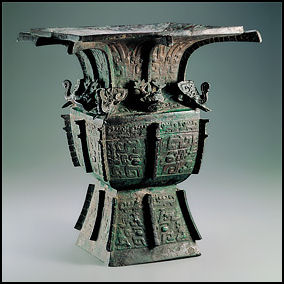
Shang ritual bronze from
Taipei's Palace Museum
Perhaps the figure most used for decorative purposes in China is the Dragon. It is to be seen in temples, on silverware, and cloth of all kinds, and next to the depiction of bending bamboo is perhaps the most familiar symbol of that land. The dragon is the most important of the four symbolic animals of mythology--to the Chinese it symbolizes nobility and power and is believed to be immortal. It can live anywhere--in the air, underground, in water.; it is believed to possess such power that, when provoked, it can spit a deadly vapor which it can turn into either water or fire at will. [Source: The Religions of South Vietnam in Faith and Fact, US Navy, Bureau of Naval Personnel, Chaplains Division,1967 ++]
According to the National Palace Museum, Taipei: “The period, from the 3rd century B.C. to the 2nd century AD, was when the appearance of the dragon became standardized. The features of Han dynasty (206 B.C.-220AD) dragons often include a semi-crouched position suggesting movement as the dragon looks up and appears to fly and dance about. In a grand manner, it possesses an impressive and energetic feeling. Structurally speaking, its head is proportionately large with a long mouth similar to that of a horse. The upper jaw is extended to become a curling, fleshy snout. The corner of the mouth goes back to the ear area, making the large mouth, sharp teeth, and snake-like tongue stand out. Han dragons have either long, sharp horns or short ones like those of sheep. Whiskers appear now, but they are few and short. The neck and body are slender, but more defined than those of a snake, while the tail is similar to that of tiger and oscillates along with the body in an energetic motion. Legs are powerful and the claws, usually numbering three and similar to those of a bird, are sharp. Generally speaking, armor-like scales appear, but not over the entire body (such as the legs). [Source: National Palace Museum, Taipei, npm.gov.tw ]
Dragons in the art of this period, from the 3rd to 6th centuries, do not differ much from those of the Han dynasty. Their bodies, however, have become lighter and tails more graceful than the powerful, curling ones of the previous period. The flowing tails follow the swift movement of the body. Head and mouth appear to have become shorter, while the horns are set in form. The horns, emerging from just above the eyes, bend back and then curl forwards at the end, giving the dragon a light and springy feeling. Tongues are long and often stick out like a snake, while the upper jaw is pointed. Scales are small and dense, revealing a distinct underbelly. The legs, slender like those of a bird, are nonetheless powerful and have sharp claws. The style of dragons in Southern Dynasties (317-589) art is bold yet light, while that of the Northern Dynasties (386-581) has a more noble and flowing disposition.
Dragons in the art of this period, from the late 6th to mid 10th century, became stockier and shown in a greater variety of poses Dragons in the art of this period, from the late 6th to mid 10th century, became stockier and shown in a greater variety of poses. Bodies, legs, and tails curl about as they twist and prance. Especially common is a dragon with its tail twisted around one of its hind legs, one of the characteristic features in the T'ang dynasty (618-907). Scales on the body are delicate and evenly distributed, creating for a rich yet refined appearance. The tongue often curls outside the large, open mouth for an energetic effect. The sharp fangs are clearly rendered. The long, curved horns grow from the temples above the eyes and are usually forked at the base. Ears are thick and prominent, while the mouth is long and thin. Whiskers are fewer and less prominent, appearing as tufts of hair. The hair extends down the leg to three sharp claws. Another popular motif of the period is known as a "dragon-fish," which has a dragon's head and a fish's body and tail. The large head has an open mouth and sharp teeth. The eyes are prominent and round, while the nose flares and curls upward.
The dragon appeared as a genre in painting during the Song Dynasty period (960-1279). Kuo Juo-hsu, in his "Record of Experiences in Painting," wrote that, "Those who paint dragons divide them into three parts; from head to shoulders, shoulders to hind legs, and then finally to the tail. Dragons have nine features (similar to other animals); horns like a deer, a head like a camel, eyes like a spirit, a neck like a snake, belly like a clam, scales like fish, claws like an eagle, paws like a tiger, and ears like an ox." This became the set pattern for the form of the dragon. Consequently, the bodies of Song dragons often look like those of pythons as the tail extends almost as part of the trunk of the body. The two horns on the head grow further back. The nose is also located back towards the eyes, and the open mouth reveals rows of teeth. When the mouth is closed, fangs are revealed. The mane appears like hair growing from the head and flows back together, while the ears are rather small. Whiskers are few and the leg muscles are much more developed. Scales only grow to the outside of the thighs. The number of claws range from three to five, but three and four are more commonly found.
The bodies of dragons in Yuan dynasty (1279-1368) art became stronger with their thinner necks and long bodies often shown prancing about freely The bodies of dragons in Yuan dynasty (1279-1368) art became stronger with their thinner necks and long bodies often shown prancing about freely. Eyes appear smaller and are shown as round, vibrant forms. The head tends to be flat and long with whiskers and hair that flare with motion. Another characteristic of Yuan dragons is to show them above swirling ocean waters in a majestic flight. Dragons in the art of this period are commonly shown with four claws.
The style of dragons in Ming dynasty (1368-1644) art was even grander than that of the preceding Yuan, often appearing quite ferocious and awe-inspiring. The body became stronger, complete with horns, a bushy mane, eyebrows, leg hair, and so on. Not only are all the details shown, but the dragon is also handled a complete and even way. The full mane, for example, is often shown flying back in a very decorative manner. The mouth is either open or closed, while the nose is often shown like a scepter, emphasizing its auspiciousness. Regardless of whether the view of the head, the scepter-like nose is always prominently displayed. The claws are often shown in a circular pattern. In addition, a kind of dragon in the Ming dynasty was shown frontally with the head placed in the center of the motif as the neck curved down to create a curving form with horns, hair, whiskers, and claws distributed over the space. The tail curves back up, adding the final touch to a grand and majestic symbol of imperial power.

Song-era painting of Nine Dragons
The spirit of dragons in Qing dynasty (1644-1911) art was obviously stately and grand in disposition. The head was wide and full, often having a bumpy surface. The space between the horns was widened, placing them even further back on the head. The mane tends to be thicker and shown in clusters flying about. The nose tends to be scepter-shaped or broad like that of a lion. Whiskers have been relegated mostly to the nose, appearing as long spikes. The lower leg, especially towards the claw, is narrower, making the dragon appear even more refined and graceful with the flaring end mane of the tail.
Dragons and Phoenixes in China
According to the National Palace Museum, Taipei: “In China, the dragon and the phoenix are traditional animals symbolic of auspiciousness. Along with the lin and the tortoise, they were known as the "Four Supernatural Spirits." The dragon and phoenix, in addition to serving as auspicious symbols, were often a metaphor in ancient China for the gentleman and the sage. For example, Confucius reportedly compared Lao-tzu to a dragon; both reserved yet elusive spirits capable of freely transcending the boundaries of heaven and earth. Lao-tzu is also said to have compared the wisdom and grace of Confucius to the lofty virtues associated with the phoenix. [Source: National Palace Museum, Taipei, npm.gov.tw ]
According to ancient records, the dragon appeared in a magical variety of forms. It could be long or short, small or gigantic. It could be both secretive yet active, and it also inhabited everywhere from the heights to the depths. Traveling between the skies and earth, dragons were considered the mounts of heavenly deities. They also had the power to control rain. During times of drought, dragons could bestow precious water, and in times of flood, they could stop the rain and clear the skies.
“The phoenix was commonly referred to as the "King of Birds." A supernatural bird, it embodied the five virtues of benevolence, righteousness, propriety, wisdom, and sincerity. As such, it harmed neither a single insect nor blade of grass. It perched only in the finest firmiana tree, eating and drinking nothing but bamboo seeds and sweet spring water. Therefore, any reported sighting of a dragon and a phoenix was considered an extremely auspicious sign, said to herald a glorious period of peace and prosperity for the people and the country. This is reflected in the Chinese saying, "When the dragon soars and the phoenix dances, the people will enjoy happiness for years, bringing peace and tranquility to all under heaven."
We know from ancient texts and artifacts that the dragon and the phoenix were auspicious animals as early as the Neolithic age in China. Highly revered and appreciated, images of dragons and phoenixes found their way onto ceremonial jade ornaments and were carved, painted, or sewn onto objects of everyday use — representing reverence for the spirits and desire for auspicious fortune. This custom was passed down through the ages. From references of dragons and phoenixes in local festivals and rites to the heights of literature and fine art, they all reveal the glory of these legendary animals. Ever since the Qin dynasty (221-206 B.C.), when the First Emperor of China proclaimed himself descendant of the dragon, almost every ruler was referred to as "The True Dragon, Son of Heaven." The dragon thereby became a symbol of the ruler, while the phoenix became an embodiment of his mate.
The forms of the dragon and phoenix were transformed gradually into images associated with the court, representing imperial nobility and authority. Almost everything related to the court, from the decoration of palace architecture down to the insignia on everyday objects and clothing — even covers and cases for books — were adorned with images and patterns bearing imperial dragons and phoenixes. These appear in a variety of materials, ranging anywhere from jade to paper. Even in the same medium, they take on different appearances, such as the case with paintings in monochrome ink or color. Of every imaginable type and pose, dragons and phoenixes not only serve as decoration, but also seem to come alive, making them "true" treasures of ancient Chinese arts and crafts.
Museums and Collections of Chinese Art
The three best collections of Chinese art are in Taipei, Beijing and Shanghai, with the best of the best at the Palace Museum in Taipei. Museum, followed by the Palace Museum, Beijing and the Shanghai. Often a museum will have a prized and valuable work of art but if you go there it is not on display. This because such works are often too old and fragile to be taken out of storage Curators in Taiwan and China are reluctant to lend out their pre-Ming dynasty paintings and calligraphy to other museums because of the extreme fragility of ancient silk, paper and brocade. The Metropolitan Museum of Art in New York has a pretty good Chinese art collection. Some university museum such as the one at Princeton have some fine pieces. The most renowned dealer of Chinese art for a while was London- and New York-based Giuseppe Eskenazi.
Most of the imperial collection of art has been lost to war, chaos, invasions and dynasty changes yet much of it has survived. When French and British soldiers looted and burned down the Summer Palace outside Beijing in 1860 almost all of the art works were taken. Many prized pieces of Chinese art in museums and galleries around the world were obtained during the period of chaos and war after the collapse of the last Chinese dynasty. After the last emperor Pu Yi abdicated in 1911 he and his large retinue supported themselves for another decade and a half in the Forbidden City by selling works of art. In 1925, a warlord offered to sell the American multi-millionaire J.P. Morgan the entire imperial collection of art for $20 million. Morgan turned him down.
On the art tastes of ordinary Chinese one Chinese artist told The New Yorker, “Chinese like this kind of picture. Ugly! And they like this one — of palm trees on a beach. “It’s stupid, something a child would like. Chinese people have no taste...We’ll do a painting and the European customer won’t buy it, and we’ll show it to a Chinese person, and he’ll say, “Great.”
Story of the Imperial Chinese Art Collection Now at the Palace Museum in Taipein
The collection at the Palace Museum in Taipei — regarded as the best collection fo Chinese art in the world — came from the Imperial collection of the last Qing emperors who resided in the Forbidden City in Beijing. The collection was built up over a thousand years by the Song (A.D. 960-1279), Yuan (1279-1368), Ming (1368-1644) and Qing (1644-1911) emperors.
Hundreds of thousands of rare and valuable pieces originally housed in the Forbidden City were secreted away to Taipei's Palace Museum when Taiwan split from the mainland during a civil war 62 years ago. The story o how that happened begins in 1925, one year after the Last Emperor Pu Yi was forced to move out of the Forbidden City, when the collection became a possession of the Chinese people. Sun Yat-sen then ordered that the works from the Forbidden Palace be placed in China's first public museum. The museum was only open for three years before the Japanese invasion of China in 1931.
War and upheaval in China in the first half of the 20th century forced the entire collection to be moved several times. First it was taken from Beijing to Nanking, then it was taken to Sichuan, where most of the collection was hidden in caves during the Japanese occupation.
China still claims Taiwan as part of its own territory and insists the art at Taipei's Palace Museum rightfully belongs on the mainland. The mainland Chinese complain the objects in the Palace Museum in Taipei were looted by Chiang Kai-shek and the Nationalists and should be returned. However their presence in Taiwan during the Cultural Revolution no doubt saved many item from possible destruction by the Red Guards.
Beijing's Palace Museum lent dozens of items to Taiwan for an exhibition in 2009, but Taiwan is still hesitant to lend China artefacts out of fear that they will not be returned. An official with Taiwan's Palace Museum said the ownership concerns meant there were no immediate plans for an exhibition in China.
Moving the Imperial Chinese Art Collection Around
The Imperial collection in the Forbidden City was placed in 19,557 filled boxes first taken from Beijing to Nanking via Chengchou, Hsuchou and P'uk'ou. The transfer of the art-filled boxes took from February to June 1933 and required five trains, each with 39 sealed cars. Because there was no place to adequately store the art in Nanking, the collection was moved to Shanghai, where it stayed until 1936 when it was taken back Nanking.
After the battle for Shanghai in August, 1937, which involved the Japanese, the collection was divided into three shipments that were taken by train, truck, steamboat and hand-towed barges to various points around China at different times, keeping one step a head of the wartime hostilities. One shipment followed the Yangtze river inland, a second went south to Guilin and a third went north to Hsuchou, Xian, before all three were united again in Leshan in Sichuan province.
China's most valuable collection of art was hauled across rivers threatened with flooding and roads vulnerable to mudslides and landslides. Works were carried on the back of coolies and hidden in caves, temples and warehouses. When World War II was over the works of art were moved back Nanking. When the Communists threatened Nanking in early 1949, during their takeover of China, the collection was loaded onto three leaky freighters in Shanghai that sailed to Taiwan.
The team that catalogued the works of art were under surveillance all the time. They were not permitted to be alone with the works of art and their uniforms didn't contain pockets. The fact that nothing was lost or damaged during the collection's odyssey is an achievement unequalled by any other museum in the world.
Finding Art in China
The large numbers of construction projects in recent years have helped archeologist unearth all kinds of things. An art historian told the New York Times, “It is almost impossible to dig anywhere in China without finding something: even if you have a little plot of land behind your house you can’t do gardening without this stuff spilling out.” There are laws in place in many places that require developers to have archeologist check for ancient remains before a factory or building can be built.
So many great treasures are being unearthed in China that the China Daily News yawned "Just Another Wonder" when some excellent Tang dynasty bronzes were unearthed near Xian and perfectly preserved string and percussion instruments from a nearly whole 5th century B.C. orchestra were discovered.
Many priceless items have also been lost by negligence and ignorance. Farmers destroyed priceless 2,000-year-old Han lyres and flutes because they had "inauspicious" tiger motifs on them and pig keepers in Hengyang County destroyed sixty ancient tombs when they used the bricks from mausoleums to make pig sties.
Image Sources: Palace Museum, Taipei; University of Washington
Text Sources: Palace Museum, Taipei, Metropolitan Museum of Art, New York Times, Washington Post, Los Angeles Times, Times of London, National Geographic, The New Yorker, Time, Newsweek, Reuters, AP, Lonely Planet Guides, Compton’s Encyclopedia and various books and other publications.
Last updated November 2021
